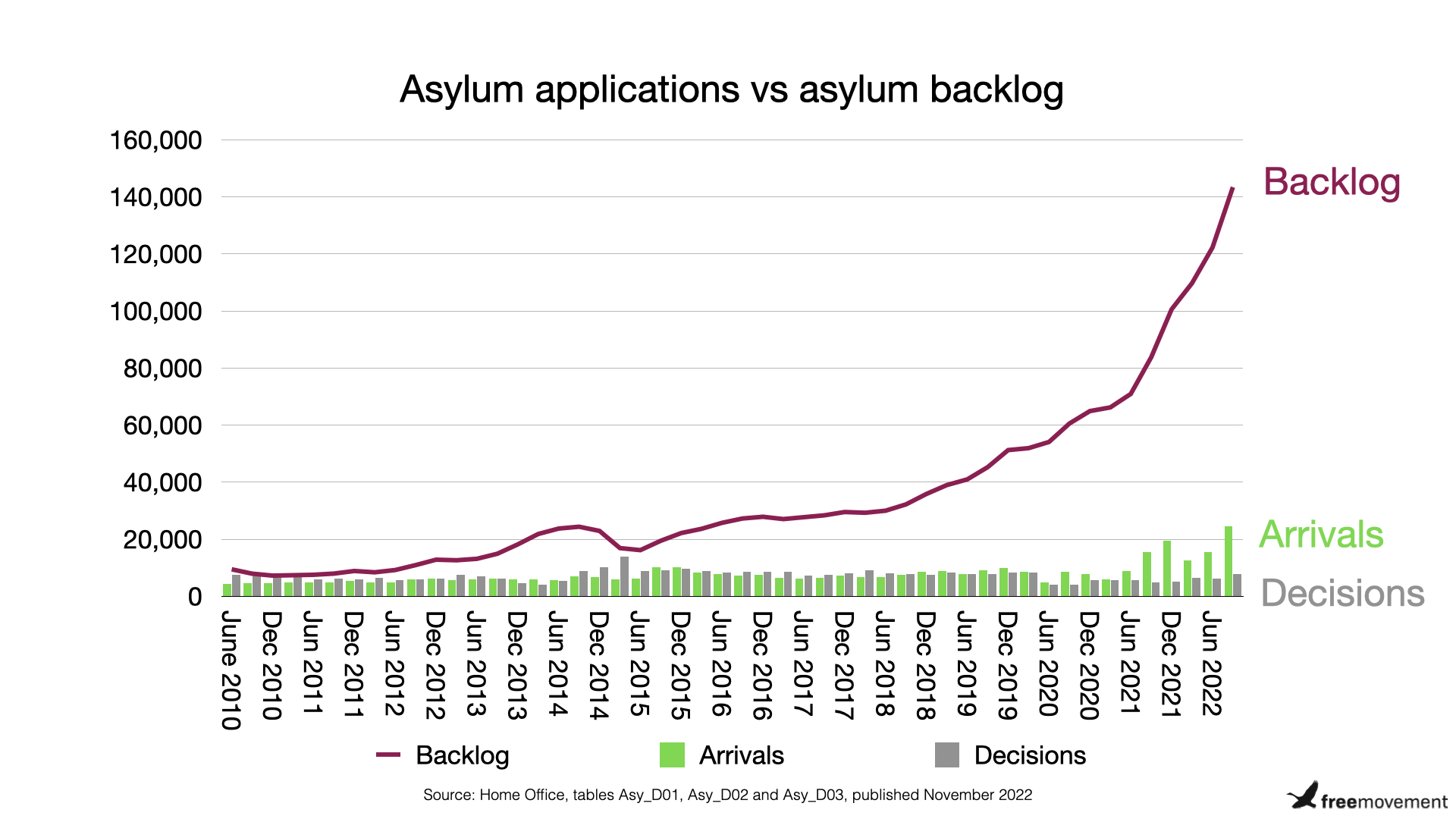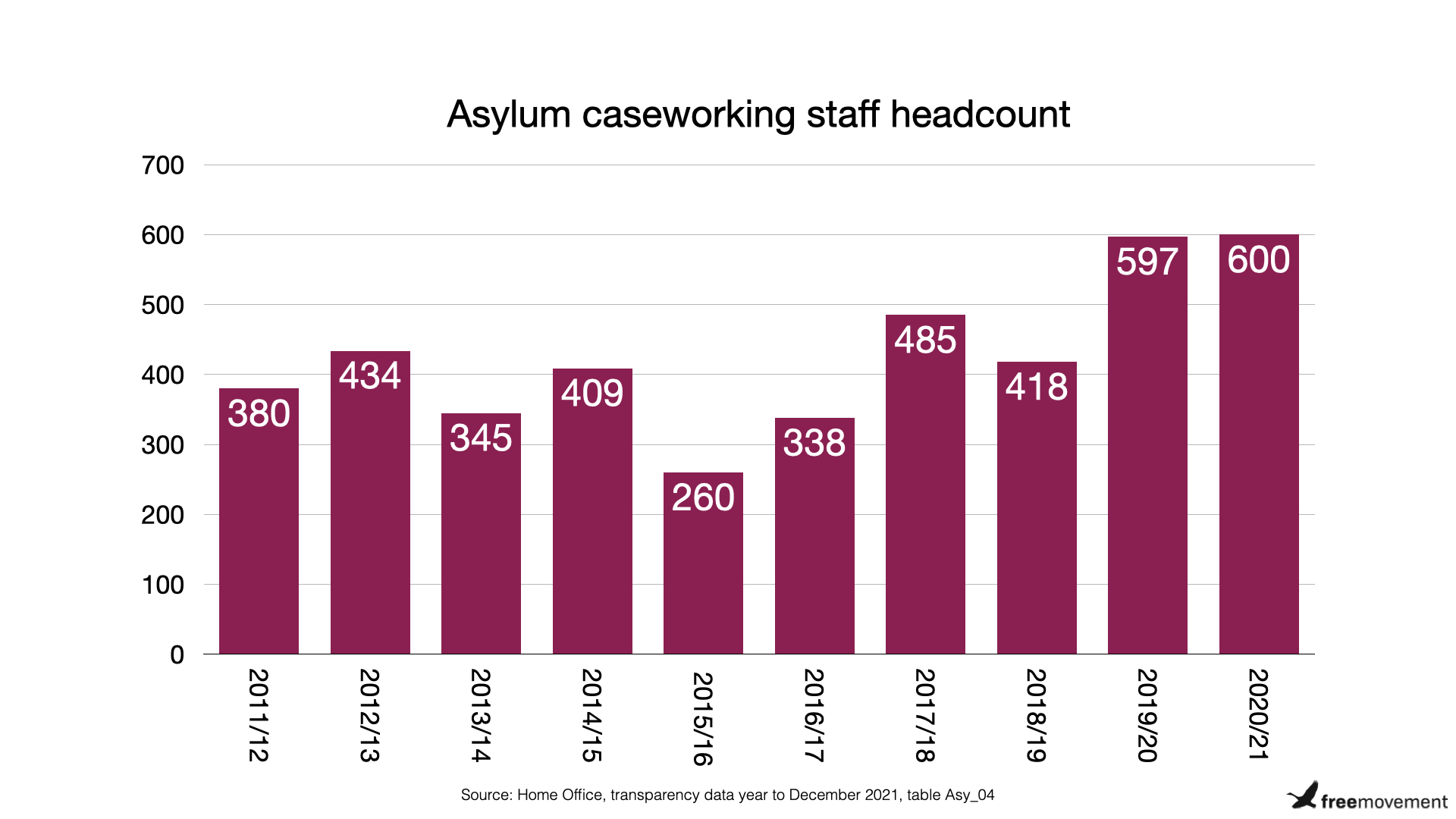- BY Josie Laidman

Asylum backlog hits 150,000 and net migration hits 500,000
Table of Contents
ToggleYesterday the Home Secretary faced questions in front of the Home Affairs Select Committee. Today the quarterly statistics on immigration were released by the Office for National Statistics. What do the two say about the state of the asylum process, backlogs and whether there is a brighter future in store?
The backlog
Asylum applications have continued to rise as the year has gone on. In the year ending September 2022, there were 72,027 asylum applications relating to 85,902 people. The previous largest peak was a total of 84,132 applications in 2002.
Over the last year, there were only 16,400 initial decisions made. There are now 117,400 applications outstanding, relating to 143,377 people. This is a 74% increase from last year. Of those individuals, 97,717 have been waiting more than six months for a decision. Of the decisions that have been made so far, 77% were grants of asylum; a historic high.

The backlog is made up of a significant number of cases from five countries. 39,408 applications (34% of the backlog) come from individuals from Iran, Afghanistan, Eritrea, Syria and Sudan. These are all countries that have a historically high number of application approvals. For example, the grant rate for Afghan nationals is 82%, for Syrian nationals is 98%, and for Sudanese nationals is 86%.
Since the inadmissibility rules were changed in January 2021, there have been 18,494 “notices of intent” issued. These essentially pause an asylum decision for up to six months in most cases. Only 83 have received an inadmissibility decision, and only 21 have been removed because of a negative decision. Over half of the people that received a notice of intent have had their claim admitted into the asylum system already. The inadmissibility rules continue to add delay to asylum claims being processed without clear data justifying them.
Safe and legal entry to the UK
One of the most news-worthy moments in the committee hearing was Tim Loughton’s question to the Home Secretary on whether a 16-year-old boy facing persecution in his home country, but with a brother settled in the UK, had a safe and legal route to the UK. The Home Secretary did not manage a coherent answer.
In the year ending September 2022, 90% of small boat arrivals claimed asylum or were recorded as a dependent of an asylum applicant. Small boat arrivals have accounted for 45% of the total number of people claiming asylum. If there was a safer, legal route to the UK it seems likely these individuals would take it.
However, the delays in decision-making inevitably mean that the people arriving on small boats in recent months are unlikely to have their claim decided any time soon. There is a level of uncertainty about whether all of these individuals have a viable claim. Of those entering the UK by small boat in the last year, 98% are still awaiting a decision, and 83% of all asylum applications since 2018 are still awaiting a decision.
The only answer the Home Secretary and her team could come up with in answer to Tim Loughton’s headline question was that there is a safe and legal route available through the UNHCR agreement. But the UNHCR are currently only able to offer a limited number of refugees resettlement to the UK each year. Most simply don’t have access to a safe regular pathway to the UK. Perhaps they should have mentioned refugee family reunion…
In 2022, 1066 refugees arrived in the UK under the UNHCR resettlement programme. A quota of 2000 referrals of Afghan refugees has also been made available for the UNHCR to submit to the UK between January 2022 and March 2023. The UNHCR has advocated for the schemes made available for Ukrainian and Afghan nationals and the creation of new safe routes. But these schemes are not without issues.
There are 9,242 Afghan refugees in hotels, 15 months after the evacuation. Only 7,572 are in settled accommodation. Entry to the UK through legal routes even for these nationals is not certain. As the situation in Afghanistan worsens, and the Afghan citizens resettlement scheme only aims to resettle 5,000 in 2022, individuals have resorted to finding alternative options. From January to September 2022, 15% of small boat arrivals were from Afghan nationals. For now, it seems like “illegal” routes to the UK will continue.
Safety in Albania, legal entry, and meritorious claims
Last year, the government signed an agreement with Albania for the safe return of Albanian nationals. Since then, the number of Albanians entering the UK has gone up by 15%. Of the 72,027 asylum applications made in the year ending September 2022, 13,650 were Albanian, making them the largest single nationality claiming asylum. Numbers had been fairly low but increased sharply over the summer.
The agreement signed last year stipulated a high level of cooperation and co-located officials from the UK and Albania stationed at various locations to support the policy. Only one was identified: an Albanian police officer stationed at Manston. The operational impact of the agreement can apparently be seen in the biometrics data shared between the two countries. Evidence at the committee hearing said that just last week, 26 more Albanians were returned to their country, and over 2,000 have been returned since 2019. The police officer at Manston assists with understanding the “cultural impact”, whatever that means.
The Home Secretary claimed that there are abuses to the modern slavery protection system. But it is the Home Office themselves that have to refer people into the National Referral Mechanism for those making claims to be a victim of modern slavery and there is a very high recognition rate. In 2021, there were 12,721 referrals. In the same year roughly 90% of decisions either at the reasonable or conclusive grounds stages, were positive. The committee asked questions on whether there was evidence that individuals were aware that they were able to make a modern slavery claim at the point of arrival, or whether they were making these claims so late on in the asylum process because this is simply the time this has come to light. No conclusive answer was given.
More than 40% of asylum seekers can’t access legal representation. With an ongoing crisis in the legal aid system, this is unlikely to change any time soon. The asylum process is complex and only works for people who can obtain legal assistance. There is a legal obligation for asylum seekers to have access to a lawyer that we have seen breached on several occasions this year. The Home Office is currently facing a legal challenge because of the failure to give asylum seekers access to lawyers at Manston.
Home Office staffing: clearing the backlog
More than one billion pounds of Britain’s overseas aid budget was spent accommodating asylum seekers and refugees in the UK in the past year. Diverting aid money from developing countries to British hoteliers is hardly good practice. Evidence at yesterday’s committee hearing confirms that the Home Office is spending money upfront to try to combat the backlog, and subsequently reduce the expenditure. They are expected to have 1,300 caseworkers by March 2023, over double the number in post in 2021. And a retention allowance will be given to staff, given that they are amongst the lowest paid civil servants. Staff will be paid £1,500 more after the first year and £2,500 more if they are in the role for two years or more.

Changes to the way staff work include an ambition of people making at least three, but preferably four decisions per week by May 2023. However, caseworkers are only provided with limited training including two full days when they start their role. There are reports of new staff deciding complex cases, which could lead to detrimental decisions and costly appeals for the individuals claiming asylum. At yesterday’s hearing, it was confirmed that their country policy guidance was provided for every country and these are used as the basis for decision-making.
A historic high of 52% of asylum appeals were allowed last year. There were only 3,543 appeals lodged during this period, though. With so few refused asylum claims, appeals are not a significant contributing factor to the backlog.
Apparently, the Home Secretary doesn’t have any target dates for sorting out the asylum backlog, which makes it difficult to see how the Home Office plans to measure whether their initiatives have been successful.
Net migration
Over one million people moved to the UK last year, but over half a million also left. Net migration was therefore just over 500,000 in the last year. This is the highest net migration figure on record. The year before, net migration was around 170,000. The pandemic has had an impact over the past few years and the increase is partially due to the travel sector recovering over. The updated immigration system and the arrival of country-specific visa schemes have also significantly contributed.
The Ukraine visa scheme routes and the Hong Kong BN(O) route have contributed to 45% of the increase we can see this year. The rest is due to an increase in students (39%) and working visas (23%), including temporary work routes such as intra-company transfers, seasonal workers and the youth mobility scheme.
There were nearly half a million extension applications made this year, up by a quarter on pre-pandemic levels. This includes EU Settlement Scheme applications, and the future figures will inevitably also include an increase in Ukraine scheme applications.
Comment
If application and decision rates stay the same as they have been for the last year it won’t be long before we hit a landmark figure of over 200,000 cases in the backlog. The Home Secretary told the committee yesterday that she agreed that the backlog was too high and confirmed that they are “developing comprehensive plans to tackle and reduce the asylum backlog”. Next year’s figures will begin highlighting how useful the staffing plans in the Home Office have been. Any details on other comprehensive plans that consider the implications for both net migration and asylum claims will be welcomed.
